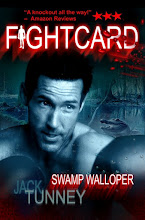FIGHT
CARD SHERLOCK HOLMES!
IN
ANTICIPATION OF FIGHT CARD’S DECEMBER RELEASE, FIGHT CARD SHERLOCK HOLMES: WORK
CAPITOL, AUTHOR ANDREW SALMON PROVIDES US WITH A VICTORIAN BARE KNUCKLE BOXING
PRIMER ...
Boxing has evolved
and changed since ancient times and boxing in Victorian times was a different
animal than boxing today. In the early 1800s, bare knuckle boxing was king.
Earning lavish purses, toasted wherever they went, hired as boxing instructors
or bodyguards for the rich aristocracy, who also funded their bouts, bare
knuckle fighters (or rawsmen) were the rock stars of the day.
Fighters lived
fast and hard, spent their fortunes without a thought, usually dying young from
drink, the long-term effects of their sport, or from diseases that were beyond
medicine at that time. This up and down lifestyle made it common for fighters
to know the inside of a debtor's prison or seek work as porters, blacksmiths,
and on the docks between fights. Some survived the sport such as John Gully who
was elected to Parliament. Most died poor and destitute.
The fights
themselves were raw, brutal affairs until The Pugilistic Club was formed in
1834 as a governing body to regulate fights, make sure fighters were paid, and
retained an official ring-maker. This lead to the Prize Ring Rules of 1838
which created some guidelines for bouts, eliminating head butts, hitting or
kicking a man when down, and outlawing spiked boots or cleats.
Stripped to bare
chest and britches, a fighter would step into the ring, tie his colors to a
corner post, proceed to the middle of the ring.
There, a scratch line would
drawn in the sawdust, sand, or earth (if the fight was outdoors). The fighters would toe the line and begin fighting until one or both fighters were
knocked down. At which point, the scratch
(or round) was over, and both fighters had to return to their corner. Rounds
lasted until a knockdown, so a single scratch
could last from mere seconds to forty-five minutes or longer, depending on the
skill of the combatants.
No stools were
provided in the corners, in fact using one was considered a foul. Rather one of
the fighter's seconds would go down
on one knee, creating a bench for the
fighter to sit on to take water from a damp sponge. From the moment a fighter
retreated to his corner, he had thirty seconds to return to the scratch line in
the center of the ring, toe the line, and resume fighting. If he didn’t (or
couldn’t), the fight was declared over and the fighter still standing was the
winner. Wrestling throws and grips were also permitted and an integral part of
the fight, which were usually refereed by two umpires.
These fights
eventually gave way to the Queensberry Rules of 1867, which instituted
three-minute rounds, with a minute's rest in-between, established the
standardized ring, and also abolished the thirty-seconds to scratch rule. A
downed fighter was counted out backward, from 10 to 1, not like today where the
lone referee counts up from 1 to 10.
The terminology of
the ring was also different than it is today. To retreat after sparring was
called breaking ground. If a fighter
maneuvered to the right or left to gain a strategic advantage, it was referred
to as taking ground. Colorful terms
were also used to describe various parts of the body. The torso itself was the mark. The nose was often referred to as
the smeller, whistler, beak, snorer, sneezer, or proboscis. The mouth was called the oration trap, the tato-trap
and, of course, the kisser.
Blood was a welcome
sight at fights and a host of terms were used to describe it as a fighter drew the claret, opened a fresh tap, drew the
home-brewed, drew the cork, drew the juice, or drew the crimson, to name a few.
When a fighter
retired from boxing, a benefit was usually held by the Fancy (the brethren of the boxing ring), a celebration to raise
money for the fighter to put towards life outside the ring. Since heavy
drinking was something the majority of rawsmen had in common, most bought pubs
and ran them until they died or lost them through bad business management. Some
did prosper, living well into old age though such cases were the exception, not
the rule.
Queen Victoria's
reign spelled the beginning of the end of organized bare knuckle boxing. As the
1800s progressed, the perception of boxing as a worthwhile sport waned. People
moved on to other pursuits until, gradually, boxing lost its mass public
appeal, royal patronage and the support of influential figures in society.
This time period
also saw the rise of gloved boxing as an alternative to the bloody contests of
the past. Gloves protected a fighter's hands, allowing him to throw more
punches, whereas rawsmen had to be more judicial in their attacks for fear of
damaging their hands. As a result, gloved boxing was seen as more exciting.
However, bare knuckle boxing did not
disappear. It continued in the shadows, becoming more and more corrupt and
dangerous along the way. Relegated to seedy clubs or attics, gypsy camps, the
Navy, and canal workers, the fights continued. The bouts were no-holds barred,
primal affairs controlled by the criminal element as the 1900s loomed. For
fans, it became a sport one did not talk about in unfamiliar company, a guilty,
gritty pleasure practiced amongst a tight-knit fraternity throughout the
decades since the glory days. And so it remains to this day.




